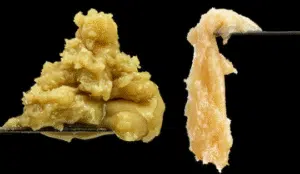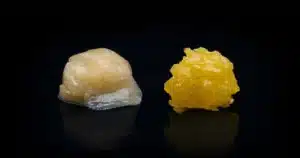Rosin is a solventless cannabis extract that is known for its purity and full cannabinoid and terpene profile. Raw rosin contains THCA and CBDA, which are inactive acidic cannabinoid forms that don’t produce psychoactive effects when consumed orally. To convert these compounds to their psychoactive form, heat must be applied.
In this guide, we explore how to decarb rosin for a fully activated compound suitable for edibles, tinctures, capsules, and other infused products.
Sections
ToggleWhat Is Decarbing Rosin?

Decarbing rosin, also known as decarboxylation, is the process of applying controlled heat to convert inactive acidic cannabinoids (THCA and CBDA) into their active forms (THC and CBD). When heat is applied to raw rosin, it removes a carboxyl group from these ingredients, unlocking the characteristic psychoactive effects. The decarboxylation process occurs during smoking or vaping rosin. However, when used in edibles, you must deliberately decarb the rosin.
Why You Need to Decarb Rosin
Learning when you should decarb rosin is essential to utilize its flavor and benefits:
You should decarb rosin when:
- You are planning to add rosin to edibles, tinctures, capsules, or any oral consumption product
- Infusing rosin into carrier oils, butter, or other mediums that require bioavailable THC and CBD
You don’t need to decarb rosin when:
- You are dabbing, vaping, or smoking rosin, as these methods utilize sufficient heat to decarboxylate cannabinoids instantly
- You want to use it for therapeutic applications that don’t need psychoactive effects
Benefits of decarbing rosin:
- Decarboxylation maximizes the psychoactive potency of rosin by converting up to 90-95% of THCA into THC
- Unlocks psychoactive properties that allow precisely doseable edibles and tinctures with predictable, consistent effects
- Makes rosin eligible for versatile applications, including infused foods, beverages, topicals, and sublingual products
How to Decarb Rosin (Step-by-Step Process)
The process to decarb rosin is simple
Step 1: Preheat Your Oven or Device
First, set the oven or heating device to the ideal decarboxylation temperature, typically 220-240°F. Preheat the oven/device for at least 10-15 minutes. Use an oven thermometer to verify the temperature.
Step 2: Prepare Your Rosin
Spread your rosin on an oven-safe container or on parchment paper and cover it with your dish. Covering is essential to prevent valuable terpenes from evaporating. Decarbed rosin maintains better flavor when contained during heating.
Step 3: Heat Evenly
Always place rosin at the spot where heat will be evenly applied. Closely monitor rosin’s appearance-you’ll notice small bubbles forming as CO2 releases. This indicates active decarboxylation, and the process is complete when bubbling slows to nearly stopped.
Step 4: Cool and Store
After decarboxylation, cool down the rosin to room temperature and store the decarbed rosin in an airtight, light-protected container in a cool location.
Key Factors for the Best Results When Decarbing Rosin
How you incorporate decarboxylated rosin into products makes a significant difference. Here’s what you should keep in mind:
Pressing Temperature
Pressing temperature is crucial for correctly decarbing rosin.
- Rosin pressed at lower temperatures (160-180°F) retains more THCA, requiring full decarboxylation treatment
- Rosin pressed at higher temperatures (200-220°F) undergoes partial decarboxylation during extraction, potentially requiring reduced decarb time
Time and Temperature Balance
Understanding what temp to decarb rosin is essential, as overheating can result in degradation:
Temperature (°F) | Time (Minutes) | Notes |
220°F | 45-60 minutes |
|
230°F | 30-40 minutes |
|
240°F | 20-30 minutes |
|
Choice of Oil or Carrier (for Infusion)
Adding decarb rosin directly into carrier oil makes absorption a lot more efficient. Here are the best options:
- MCT oil: With neutral flavor, MCT (medium-chain triglyceride) oils are excellent for cannabinoid solubility. It offers long shelf life and easy sublingual absorption.
- Olive oil: Rich in beneficial fats, olive oil as a carrier enhances cannabinoid bioavailability. It is suitable for culinary applications.
- Butter: A traditional choice for edibles, adding decarbed rosin to butter offers a familiar taste and excellent cannabinoid binding.
Applications for Decarbed Rosin

The application scope of decarbed rosin is wide:
- Edibles: Decarbed rosin is excellent for brownies, gummies, chocolates, and any food product, as it provides potent, long-lasting effects
- Tinctures: Products like sublingual drops made by infusing decarbed rosin into alcohol or MCT oil offer fast absorption
- Topicals: Activated cannabinoids in creams, balms, and other topicals use decarb rosin for offering localized relief without psychoactive effects
- Capsules: Decarbed rosin in gelatin or vegetable capsules makes for precise dosage, delivering consistent, predictable effects
Tips to Preserve Potency and Flavor

- Always use an oven thermometer to verify actual temperature; it will ensure precise temperature control, preventing over-decarboxylation
- Vacuum sealing rosin before decarbing can prevent terpene loss, but this will need specialized equipment.
- Ensure temperature doesn’t exceed 250°F, as such high temperature may degrade THC into CBN and burn off terpenes
Clean, Potent, and Powerfully Psychoactive
Decarboxylation of rosin is crucial for maximizing its oral bioavailability while maintaining clean, solvent-free purity. Decarb rosin is a versatile ingredient that can produce psychoactive experiences through edibles, fast-acting effects via tinctures, or targeted relief through topicals. To achieve this, producers must understand how to decarb live rosin or hash rosin, enabling them to yield activated rosin without wasting expensive concentrates.
Conclusion
Whether you are a producer or a hobbyist, mastering how to decarb rosin is a skill that enables you to utilize this premium concentrate fully. Proper decarbing rosin technique ensures maximum potency activation while preserving the delicate terpene profiles. Whether creating edibles, tinctures, or therapeutic topicals, decarbed rosin is a crucial ingredient for all.




